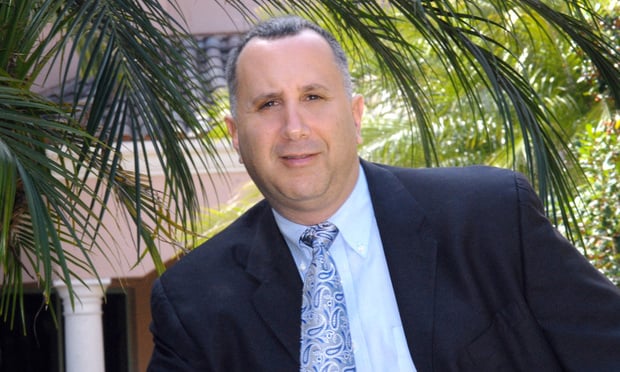Spoiler Alert: Most of South Florida's Top Law Firm Billers Are Men
Find out who's charging what in our annual survey of attorney billing rates.
March 19, 2018 at 08:00 AM
7 minute read
 Joe Ankus. Photo: Melanie Bell
Joe Ankus. Photo: Melanie Bell
No one on the list is talking, but new research on billing rates speaks for itself: Most of the attorneys commanding top dollar in South Florida's bankruptcy bar are men.
In the latest annual study of billing rates by ALM, the parent company of the Daily Business Review, only one woman appeared among the 10 highest South Florida billers: Leslie Cloyd, a Berger Singerman Boca Raton partner who represents debtors and others in complex Chapter 11 cases and workouts.
That's no surprise to many who follow financial disparities in the industry.
 Terry Jesse.
Terry Jesse.“Law firms don't want to admit it, but there is gender inequality,” said Terry Jesse, executive director of the National Association of Legal Fee Analysis, a nonprofit that undertakes fee analyses for courts and private clients. “People say, 'We don't do this at our law firm.' They don't see it, but it does come out in surveys.”
ALM researchers used federal court billing data from bankruptcy cases to compile compensation lists for attorneys and other billers in 20 U.S. jurisdictions. The top spot in this year's South Florida data belonged to Paul Keenan, a Greenberg Traurig Miami shareholder shown charging $765 per hour to clients in the firm's restructuring and bankruptcy practice.
At No. 2, Michael Goldberg of Akerman commands $655 per hour. Cloyd is next at $625 an hour, and is the only female attorney among the 34 lawyers in the ALM data who billed at more than $400 per hour. Her Berger Singerman colleague, Jordi Guso, showed a rate of $610 per hour.
Two Jacksonville attorneys billing $575 per hour, Guy Bennett Rubin and I. Mark Rubin, appear next on the list, trailed by David Softness of David R. Softness P.A. in Miami at $550; Peter Bernhardt of McDonald Hopkins in West Palm Beach at $530; and Jeffrey Bast of Bast Amron and Paul Singerman of Berger Singerman, each based in Miami and charging $525 per hour.
Rounding off the top 10 are Ehrenstein Charbonneau Calderin's Robert Charbonneau and Seese P.A.'s Michael Seese, who each charge $515 for an hour's work.
'Really Disheartening'
 Silvia Hodges Silverstein.
Silvia Hodges Silverstein.“Diversity is an important topic,” said Silvia Hodges Silverstein, executive director of New York-based Buying Legal Council, an international trade organization for legal procurement. “But until we had billing data that was also tracking gender, we really couldn't say anything about it.”
Silverstein's own research in March 2014 found similarly bleak results. At that time, she led a Sky Analytics Inc. national gender study based on $3.4 billion in corporate legal billings for 40,000 lawyers and time keepers across 3,000 law firms.
Her data uncovered “profound differences” between realized rates—the amount paid—for male and female attorneys at the same career level. Among her findings: Female associates made $27 less per hour on average than their male counterparts with similar experience.
“What was really disheartening was that you have the difference right out of law school, and it continues as women advance in their careers, even as they become equity partners,” said Silverstein, who now also lectures at Columbia Law School. “Women aren't able to make up the difference over time. His hourly rate goes up. Hers goes up, but not as much.”
At the top of the profession, Silverstein's research found six percent of male lawyers commanded more than $800 per hour, while only two percent of their female counterparts ever reach that rate. And no women in her data set surpassed the $1,000 hourly rate, while two percent of male lawyers did.
“The pay gap got even wider as attorneys moved up,” Silverstein said.
The good news: Silverstein found that women at small firms fared better than their counterparts in Big Law or at midsize firms. Lawyers at firms with 25 or fewer attorneys billed at the same rate for comparable work, and increased their prices at the same pace, regardless of gender.
NALFA's Jesse attributed the difference to the “culture” at many big firms.
“There's less gender inequality at the midsize and solo level,” he said. “At the very large firms it's just kind of a system. … A lot of it is task-based. Male partners are given more leadership roles in litigation, and female might be assigned lesser tasks—more research-based.”
Women's Work
Joe Ankus, a Davie, Florida-based consultant who's spent more than 20 years recruiting talent for law firms, said niche specialties are key when it comes to determining what attorneys can demand. He said years of specialization often separate the top billers from counterparts with lower asking rates.
“You need to be viewed as the go-to lawyer, or at least one of a handful of go-to lawyers,” said Ankus, president and founder of Ankus Consulting Inc. “The way to stay at the top: You can't be a good practitioner. You must be excellent.”
A focus on debtor-side Chapter 11 work combined with related in and out-of-court restructuring expertise appears to have helped propel South Florida's top female bankruptcy biller into the male-dominated top tier.
Cloyd and others named in the ALM billing data's top 10 declined to comment or did not respond to requests. But Cloyd's law firm profile shows her work has included serving as debtor's counsel to Ruden McClosky in the law firm's Chapter 11 case, representing Florida Power & Light in a Chapter 11 case filed by Gator Generating Corp., and representing tax collectors for Indian River, St. Lucie, St. John, Glades and Hendry Counties.
Beyond the realm of law firm partners like Cloyd, Silverstein's data, which includes legal staffers as well as attorneys, showed that women were more likely than men to bill time for lower-skill tasks.
“What we found was that there were certain 'female' jobs and they were not necessarily strategic,” Silverstein said.
In analyzing standardized billing data using Uniform Task-Based Management System coding, Sky Analytics isolated litigation billing codes, or L-codes. It found female billers outnumbered male counterparts for codes indicating low-level tasks, such as data-processing, as opposed to administrative or investigative roles.
Plus, men staffed the majority of large projects requiring teams of at least 20 billers or timekeepers. They accounted for 93 percent of that litigation, while women shepherded smaller teams. While their male colleges handled large suits, female timekeepers made up the majority of workers assigned to 81 percent of small cases, according to the Sky research.
Silverstein's data also showed women occupied entry-level positions, accounting for 75 percent of paralegals and 46 percent of associates, but only 22 percent of partners.
Firms “need to be mindful of how they staff matters,” Silverstein said. “Do they give women the same exposure to important matters as men?”
And even if they get the work, researchers say women face more pressure to discount their time—offering discounts on 37 percent of their bills, compared to 26 percent for men.
“Males in the legal profession are considerably more likely to bill through without any adjustments,” Silverstein said.
That's good news, at least, for most of the South Florida attorneys on the billing list.
This content has been archived. It is available through our partners, LexisNexis® and Bloomberg Law.
To view this content, please continue to their sites.
Not a Lexis Subscriber?
Subscribe Now
Not a Bloomberg Law Subscriber?
Subscribe Now
NOT FOR REPRINT
© 2025 ALM Global, LLC, All Rights Reserved. Request academic re-use from www.copyright.com. All other uses, submit a request to [email protected]. For more information visit Asset & Logo Licensing.
You Might Like
View All

Elite Boutiques Competing More With Big Law Bonuses, With Several Going Above Market
9 minute read

It's Time Law Firms Were Upfront About Who Their Salaried Partners Are
4 minute readTrending Stories
- 1Latham's Lateral Hiring Picks Up Steam, With Firm Adding Simpson Practice Head, Private Equity GC
- 2Legal Restrictions Governing Artificial Intelligence in the Workplace
- 3Failure to Adequately Inform Patients
- 4'FTX' One Year Later: The Impact on Examiner Practice in Bankruptcy Courts
- 5Gen AI Legal Contract Startup Ivo Announces $16 Million Series A Funding Round
Who Got The Work
J. Brugh Lower of Gibbons has entered an appearance for industrial equipment supplier Devco Corporation in a pending trademark infringement lawsuit. The suit, accusing the defendant of selling knock-off Graco products, was filed Dec. 18 in New Jersey District Court by Rivkin Radler on behalf of Graco Inc. and Graco Minnesota. The case, assigned to U.S. District Judge Zahid N. Quraishi, is 3:24-cv-11294, Graco Inc. et al v. Devco Corporation.
Who Got The Work
Rebecca Maller-Stein and Kent A. Yalowitz of Arnold & Porter Kaye Scholer have entered their appearances for Hanaco Venture Capital and its executives, Lior Prosor and David Frankel, in a pending securities lawsuit. The action, filed on Dec. 24 in New York Southern District Court by Zell, Aron & Co. on behalf of Goldeneye Advisors, accuses the defendants of negligently and fraudulently managing the plaintiff's $1 million investment. The case, assigned to U.S. District Judge Vernon S. Broderick, is 1:24-cv-09918, Goldeneye Advisors, LLC v. Hanaco Venture Capital, Ltd. et al.
Who Got The Work
Attorneys from A&O Shearman has stepped in as defense counsel for Toronto-Dominion Bank and other defendants in a pending securities class action. The suit, filed Dec. 11 in New York Southern District Court by Bleichmar Fonti & Auld, accuses the defendants of concealing the bank's 'pervasive' deficiencies in regards to its compliance with the Bank Secrecy Act and the quality of its anti-money laundering controls. The case, assigned to U.S. District Judge Arun Subramanian, is 1:24-cv-09445, Gonzalez v. The Toronto-Dominion Bank et al.
Who Got The Work
Crown Castle International, a Pennsylvania company providing shared communications infrastructure, has turned to Luke D. Wolf of Gordon Rees Scully Mansukhani to fend off a pending breach-of-contract lawsuit. The court action, filed Nov. 25 in Michigan Eastern District Court by Hooper Hathaway PC on behalf of The Town Residences LLC, accuses Crown Castle of failing to transfer approximately $30,000 in utility payments from T-Mobile in breach of a roof-top lease and assignment agreement. The case, assigned to U.S. District Judge Susan K. Declercq, is 2:24-cv-13131, The Town Residences LLC v. T-Mobile US, Inc. et al.
Who Got The Work
Wilfred P. Coronato and Daniel M. Schwartz of McCarter & English have stepped in as defense counsel to Electrolux Home Products Inc. in a pending product liability lawsuit. The court action, filed Nov. 26 in New York Eastern District Court by Poulos Lopiccolo PC and Nagel Rice LLP on behalf of David Stern, alleges that the defendant's refrigerators’ drawers and shelving repeatedly break and fall apart within months after purchase. The case, assigned to U.S. District Judge Joan M. Azrack, is 2:24-cv-08204, Stern v. Electrolux Home Products, Inc.
Featured Firms
Law Offices of Gary Martin Hays & Associates, P.C.
(470) 294-1674
Law Offices of Mark E. Salomone
(857) 444-6468
Smith & Hassler
(713) 739-1250






